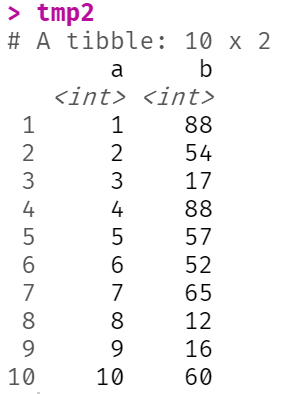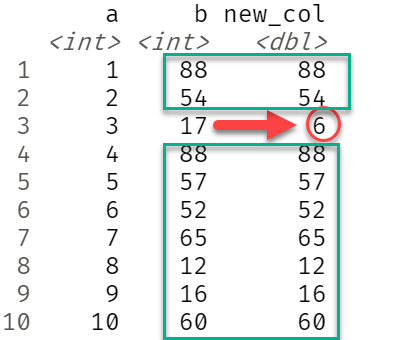Hi All,
Here is my df:
tmp2 <- structure(list(a = 1:10, b = c(88L, 54L, 17L, 88L, 57L, 52L,
65L, 12L, 16L, 60L)), row.names = c(NA, -10L), class = c("tbl_df",
"tbl", "data.frame"))
I want to add new column with mutate() and case_when, provided that: b==17 I will do a*2.
My code:
tmp2 %>% dplyr::mutate(new_col = dplyr::case_when(
b == 17 ~ a*2,
TRUE ~ b))
is not working.
tmp2 %>% dplyr::mutate(new_col = dplyr::case_when(
b == 17 ~ a*2,
TRUE ~ b+0))
is working, giving me what I want:
Why does not "b" working alone in the formula and I must add: "b+0" to make it work ?
Any explanation would be appreciated.
case when does type checking , you are implicitly asking to mix integers with doubles.
Error: must be a double vector, not an integer vector
here is a solution where you don't require moving away from integers because the arithmetic you are doing is integer based.
tmp2 %>% dplyr::mutate(new_col = dplyr::case_when(
b == 17L ~ a*2L,
TRUE ~ b))
the uppercase letter L tells R that you want the number interpreted as an integer rather than as a double(floating point number)
2 Likes
Hi @nirgrahamuk , thank you for your reply.
I didn't received an error you pointed out, but a different one:
oh, that's stange, perhaps you are using a different version of dplyr than me...
I use dplyr 0.8.99.9002 dev version.
Hi @nirgrahamuk ,
If I may ask a full question: What must be a double vector, not an integer vector ?
As my dataframe tmp2 consist of an integer vectors:
Indeed, so adding 17 and multipling by 2 would be assumed to give a double answer, as the default interpretation of 17 and 2 are that they are double's.
system
April 12, 2020, 12:20pm
8
This topic was automatically closed 7 days after the last reply. New replies are no longer allowed.


